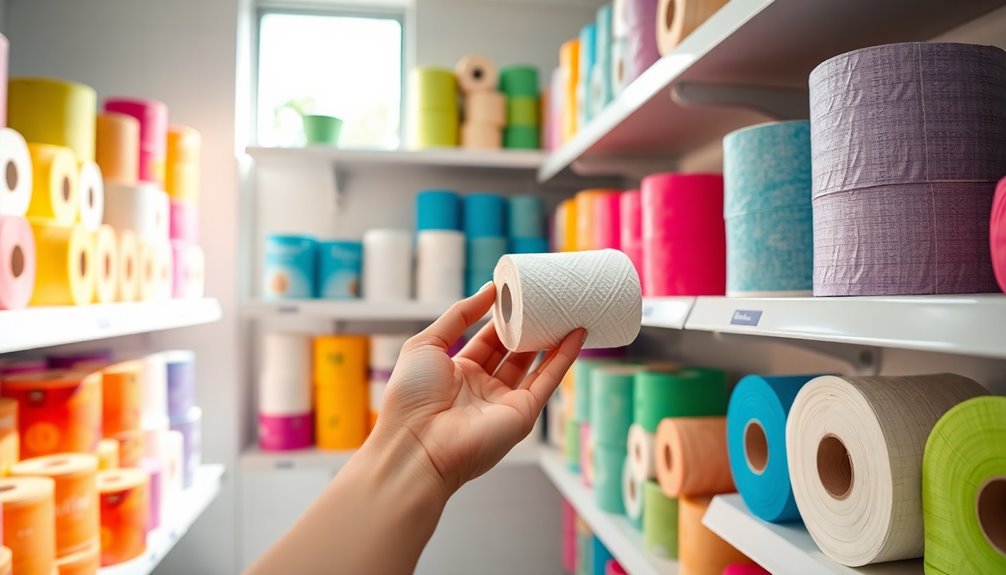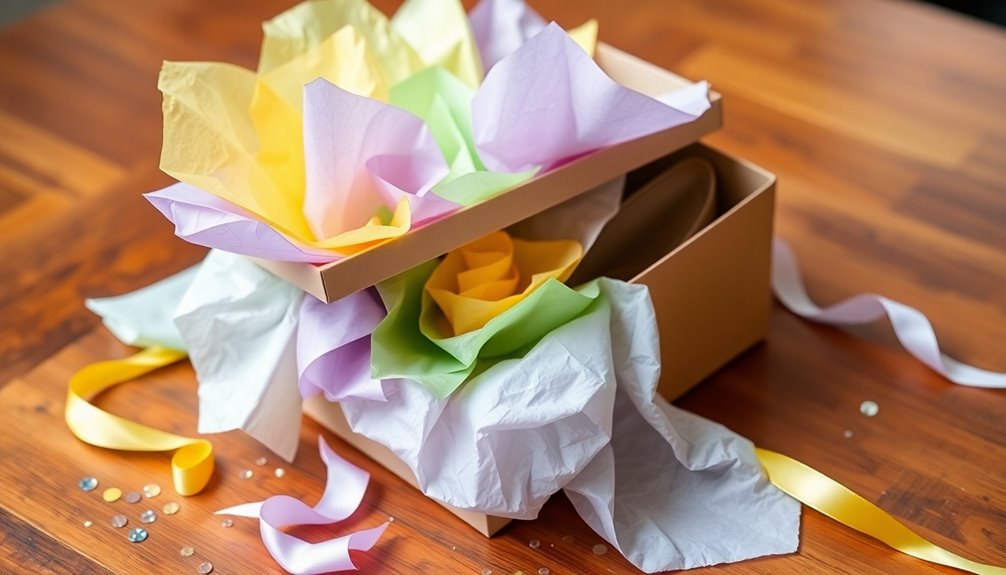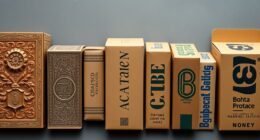Choosing toilet paper starts with understanding ply options. Single-ply is thinner and dissolves quickly, ideal for septic systems. Two-ply balances softness and strength, while three-ply offers maximum comfort but may clog older plumbing. Consider environmentally friendly options made from recycled materials, which help reduce waste. Also, think about cost—comparing cost per sheet can lead to better choices. Ultimately, compatibility with your dispenser matters for ease of use. Keep these factors in mind, and you're on the right track for a satisfying bathroom experience. There's plenty more to explore about toilet paper selection that might surprise you.
Key Takeaways
- Determine the ply type based on your needs: single-ply for quick dissolvability, two-ply for balance, and three-ply for extra softness.
- Consider eco-friendly options made from recycled materials and certified by organizations like FSC for sustainable forestry practices.
- Check dispenser compatibility to ensure your chosen toilet paper fits your existing dispensers, especially in high-traffic areas.
- Evaluate cost per sheet and consider bulk buying to save money while ensuring quality and durability.
- Test for softness, strength, and dissolvability through product comparisons to find an option that meets your comfort and plumbing needs.
Understanding Toilet Paper Types
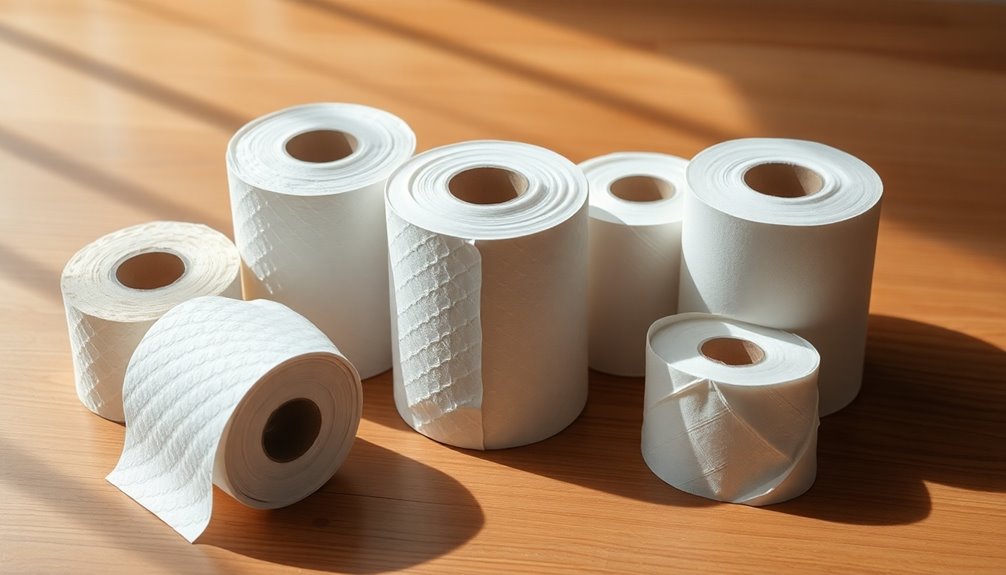
When it comes to choosing toilet paper, understanding the different types available can make a big difference in your bathroom experience.
You'll find various toilet paper types, with ply options typically ranging from single-ply to three-ply. Single-ply may save you some cash, but you might miss out on the softness and durability that comes with thicker, multi-ply options. Just remember, thicker isn't always better, as it can take longer to dissolve.
If you're environmentally conscious, consider eco-friendly toilet paper made from recycled materials. These sustainable brands, like Seventh Generation, offer comparable softness to traditional options while promoting environmental responsibility.
You'll appreciate that many eco-friendly choices are free from chlorine, making them gentler on your body and the planet.
Additionally, consider the roll sizes. Standard rolls work well for smaller households, while jumbo rolls are ideal for larger spaces, cutting down on replacement frequency and overall costs.
Some brands even offer individual sheets or hygienic interfolded designs, which enhance hygiene in high-capacity settings by reducing waste. Understanding these options will help you find the right toilet paper that meets your needs and values.
Dispenser Compatibility Matters
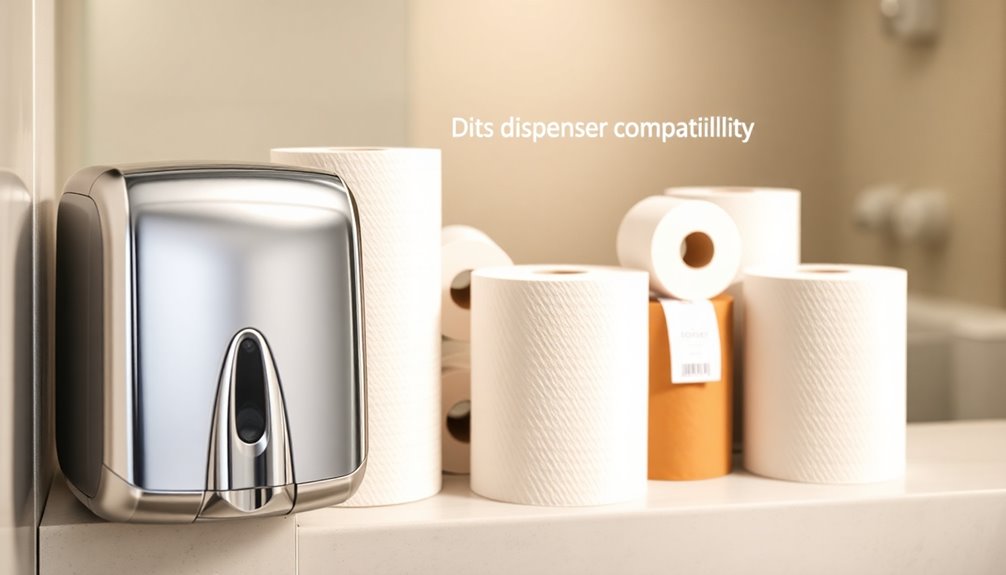
When you're picking out toilet paper, it's essential to take into account the type of dispenser you have.
Some dispensers are designed for specific sizes or core types, while others, like universal dispensers, can handle a range of options.
Understanding whether you want core or coreless rolls will help guarantee you make a choice that fits your setup perfectly.
Dispenser Types Explained
Understanding dispenser types is vital for ensuring you get the most out of your toilet paper selection. The right dispenser can make a significant difference in convenience and efficiency. Here are three key points to reflect on:
- Universal Dispensers: These versatile options can accommodate various roll sizes, giving you the freedom to choose from a wider range of toilet paper. They're great for flexibility in your selections.
- Proprietary Dispensers: These are specifically designed for certain brands, which can limit your choices. You may find that they require specific roll sizes or styles, leading to less flexibility.
- Dispenser Size: Larger dispensers suit high-traffic areas, allowing for longer-lasting rolls and reducing the frequency of replacements. This not only saves you time but can also lead to cost savings in the long run.
Additionally, don't overlook the ease of access. Choosing dispensers that make it easy for users to get toilet paper enhances user satisfaction, especially in shared spaces.
Take the time to choose the right dispenser type, as it plays a vital role in your toilet paper experience.
Core vs. Coreless Options
Choosing between core and coreless toilet paper options can significantly impact your dispenser's functionality and efficiency. Core rolls come with a cardboard tube, which often requires more maintenance and can lead to increased waste if not disposed of properly.
In contrast, coreless options eliminate the tube, reducing waste and fitting more easily into dispensers. Coreless rolls are typically more compatible with universal dispensers, offering greater flexibility in paper selection and cutting down on the need for specific proprietary dispensers.
This is particularly beneficial in high-traffic areas, where businesses prefer coreless options due to their ease of restocking and reduced maintenance needs. Plus, they generally take up less space in storage.
Additionally, some coreless brands feature interfolded sheets, enhancing hygiene by allowing users to access one sheet at a time without touching the rest of the roll.
However, it's essential to check your existing dispenser compatibility before making a purchase, as coreless rolls may not fit in dispensers designed for standard core rolls. Ensuring compatibility can save you time and effort while maintaining ideal hygiene and efficiency in your restroom facilities.
Evaluating Ply Options

In evaluating ply options for toilet paper, you'll quickly notice that the ply count considerably impacts both performance and comfort. Understanding the differences among single-ply, two-ply, and three-ply options will help you make an informed choice that suits your needs.
- Single-Ply: This option is thinner and tends to break down faster in water, making it a better fit for septic systems. It's a practical choice if plumbing safety is a concern.
- Two-Ply: Offering a balance of softness and strength, two-ply toilet paper provides more comfort while still being relatively dissolvable. It's ideal for regular use in homes with moderate traffic.
- Three-Ply: While this option is the thickest and softest, it can lead to clogging issues if not specifically designed for quick disintegration. Use it cautiously, especially in older plumbing systems.
When selecting a ply option, consider your household's user volume and expected usage frequency.
Higher traffic areas may require stronger toilet paper to prevent tearing, so weigh your choices carefully to guarantee both comfort and functionality.
Considering Environmental Impact
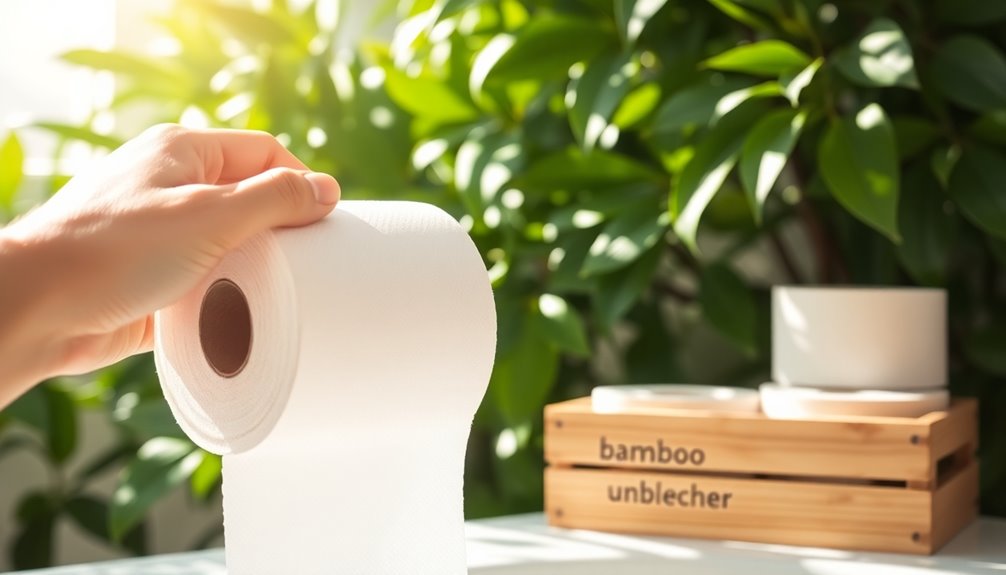
As you weigh your ply options, it's also important to take into account the environmental impact of your toilet paper choice. Opting for toilet paper made from recycled materials can greatly reduce waste in landfills and minimize the need for virgin pulp, which is essential for forest conservation.
Look for environmentally friendly products that come with FSC certification, as this guarantees responsible sourcing and sustainable forestry practices.
Additionally, choosing chlorine-free toilet paper is imperative because traditional bleaching processes can harm aquatic ecosystems and contribute to pollution. By selecting brands that avoid harmful chemicals, you help protect the environment.
Don't forget to take into account the packaging, too. Brands that use minimal packaging further lessen your environmental footprint and reduce waste associated with product delivery.
Ultimately, making sustainable choices in your toilet paper selection not only benefits the planet but also supports responsible production practices.
By committing to eco-conscious options, you contribute to a healthier environment for your home or workplace and promote a more sustainable future.
Analyzing Cost Factors
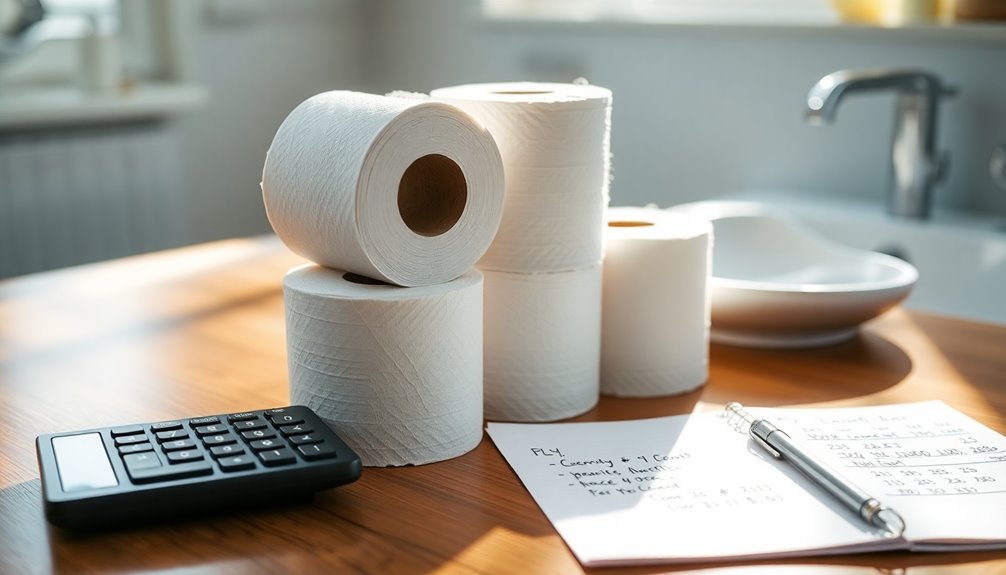
When you're on the hunt for toilet paper, it's vital to analyze the cost factors involved to confirm you're making a smart purchase. Understanding the cost per sheet is critical, especially since larger bulk purchases often reduce this cost considerably, giving you better value over time.
Here are three key considerations:
- Price Comparison: The average cost of toilet paper ranges from $0.31 to $0.39 per sheet for popular brands. Always compare prices to find the best deal.
- Eco-Friendly Options: Options like Seventh Generation 100% Recycled toilet paper cost around $0.38 per sheet. They're competitive with traditional brands and support sustainability, making them a viable choice.
- Total Cost of Ownership: Consider durability and how often you'll need to restock. Cheaper options might lead to frequent replacements, ultimately increasing your overall expenses.
Buying in bulk during sales can lead to considerable savings, as you'll often find lower costs per roll or sheet.
Common Issues With Toilet Paper
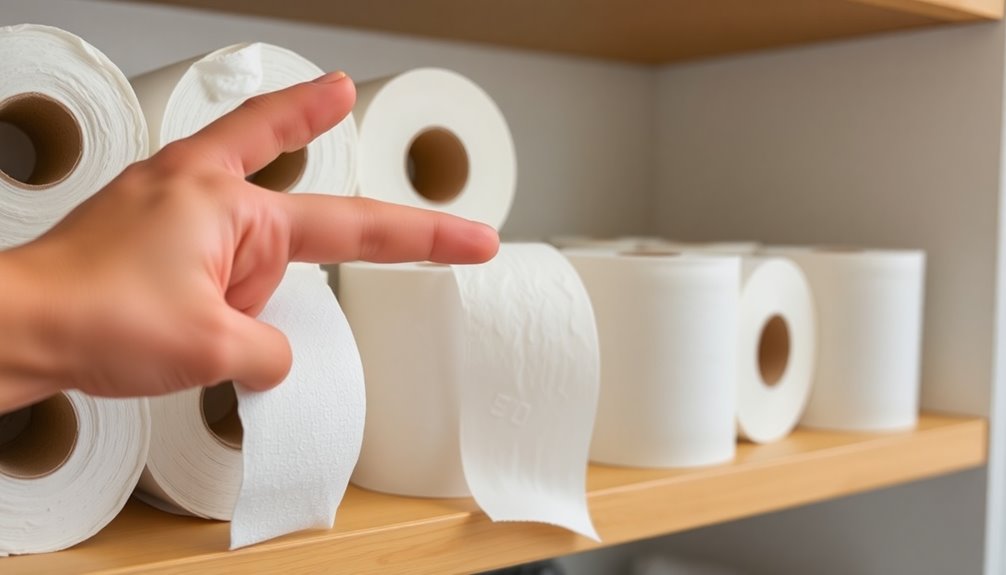
While you're considering cost factors, it's also important to be aware of common issues that can arise with toilet paper. One major concern is the shrinking size of rolls; since 2009, they've decreased by 9% to 23%. This change can confuse you about product quantity and value.
Additionally, the rise of mega, triple, and jumbo sizes complicates comparison shopping, making it tough to determine which brands truly offer the best bang for your buck.
Another issue you might face is tubeless toilet paper designs. These can be harder to unravel and may not fit standard toilet paper holders, leading to frustration.
You should also be cautious about wipes marketed as "flushable." Many take over 10 minutes to break down, posing risks to your plumbing and increasing environmental waste.
Lastly, buying store brands or larger packages during sales can help you save money, but make sure you also consider the softness and usability of the product.
Key Features to Look For

Choosing the right toilet paper involves considering several key features that can enhance your overall experience. Pay attention to the following aspects:
- Ply Count: Toilet paper varies from one-ply to three-ply. Higher ply counts offer more thickness and comfort but may affect dissolvability. If you have plumbing concerns, consider the balance between comfort and safety.
- Softness and Strength: Look for a toilet paper that strikes a balance between softness and strength. You want it to feel gentle on your skin while being robust enough to prevent tearing during use. Top-rated options excel in both categories.
- Absorbency: High absorbency is essential for effective cleaning. Some brands absorb considerably more liquid, which can enhance your satisfaction.
Additionally, consider dissolvability to guarantee that your choice breaks down easily in water, preventing clogs.
Finally, if sustainability is important to you, opt for products made from recycled materials or sustainably sourced fibers, which can provide comfort and strength without compromising the environment.
Testing Methods for Quality
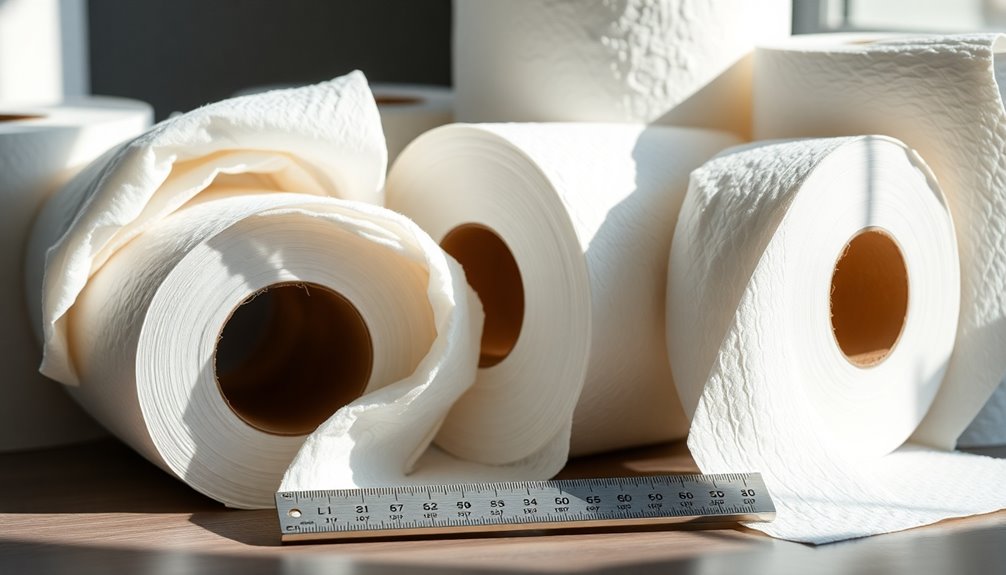
Understanding the quality of toilet paper hinges on various testing methods that confirm it meets your expectations. One vital method is strength testing, where an Instron machine measures the force needed to puncture or tear the sheets. This guarantees durability during use, so you won't have to worry about unexpected rips.
Softness is another important factor, evaluated through sensory analysis by panelists in controlled conditions. This method provides an accurate assessment of tactile comfort, making certain the paper feels good against your skin.
Pliability assessments involve manipulating the paper into a ball to gauge its flexibility and softness, enhancing your overall user experience.
Dissolvability tests measure how quickly toilet paper breaks down in water, indicating its compatibility with plumbing systems and potential clogging risks.
Finally, a thorough scoring system combines results from strength, softness, pliability, and dissolvability tests to provide an overall performance score for each product. This score helps you compare different options and choose wisely.
Always consider these testing methods when selecting toilet paper, as they play a significant role in confirming you get a quality product.
Effective Buying Strategies
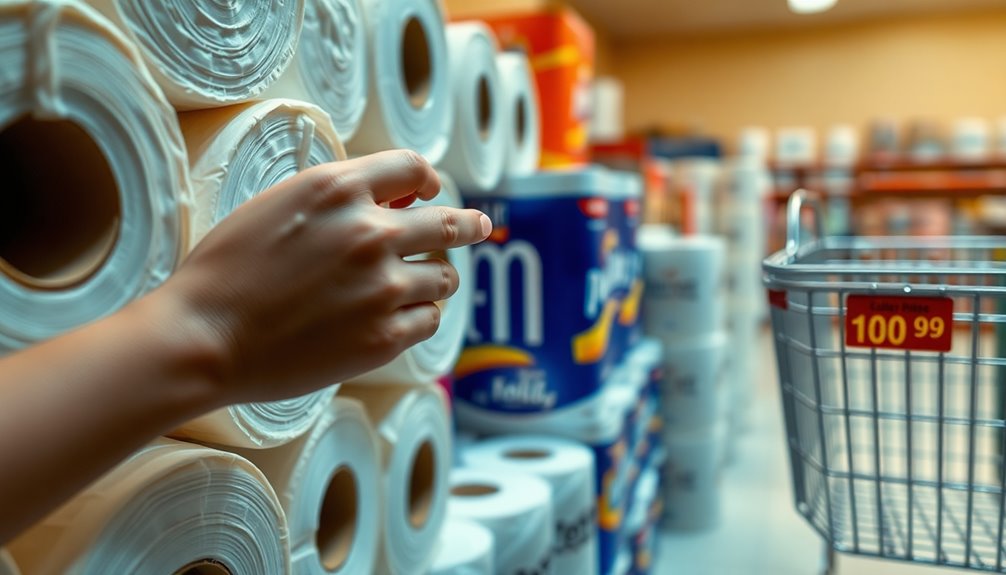
Maximizing your savings on toilet paper starts with effective buying strategies that make the shopping experience smoother and more informed. Here are three key approaches to take into account:
- Comparison Shopping: Always check unit-pricing labels to calculate the cost per sheet. This allows for effective price comparisons between different brands and package sizes, guaranteeing you get the best value.
- Stockpiling Benefits: Look out for sales and promotions. Buying in bulk can greatly lower the cost per roll. Plus, having a sufficient supply saves you from last-minute purchases.
- Understanding Labels: Familiarize yourself with terms like ply count, absorbency, and softness ratings. This knowledge helps you choose recycled toilet paper or eco-friendly products that meet your needs without compromising quality.
Additionally, don't forget to read consumer reviews. They provide real-world insights into the performance of toilet paper options, guiding you to make better choices.
Frequently Asked Questions
How Do People Choose What Toilet Paper to Buy?
When you decide what toilet paper to buy, you likely weigh several factors. You might prioritize softness and strength, often leaning towards two-ply options for comfort.
You probably consider environmental impact, opting for recycled materials or eco-friendly brands. Price matters too; you likely compare cost per sheet and find that buying in bulk saves money.
Brand loyalty can influence your choice, as familiarity often sways your decision, even if quality varies.
How Do I Choose the Best Toilet Paper?
When you're choosing the best toilet paper, think about what you value most.
Do you prioritize softness and strength, or is plumbing compatibility more important? Evaluate ply options, absorbency, and disintegration rates.
Don't forget to take into account environmental impact; recycled options can be great.
Also, check pricing per sheet—bulk buys often save you money.
Finally, verify it fits your existing dispensers to avoid any hassle.
Make your choice based on what suits your needs best!
Why Do Plumbers Say Not to Use Charmin Toilet Paper?
Plumbers often advise against using Charmin toilet paper because its thick, plush design doesn't break down easily in water.
This can lead to clogs in your plumbing system. While you might enjoy the comfort it provides, the high absorbency and strength can create blockages when combined with waste.
Instead, consider opting for thinner, single-ply options that dissolve more readily, reducing the risk of plumbing issues and keeping your pipes clear.
Is 2 Ply or 3 Ply Toilet Paper Better?
When deciding between two-ply and three-ply toilet paper, you should consider your preferences and needs.
If you value softness and durability, three-ply might be your best bet. However, if you're looking for something more septic-safe and budget-friendly, two-ply could be the way to go.
Ultimately, it's about balancing comfort, strength, and plumbing compatibility. Think about what matters most to you and make your choice based on that!
Conclusion
When it comes to choosing the right toilet paper, you've got plenty of factors to contemplate. From understanding different types and ply options to keeping environmental impact in mind, making an informed choice is key. Don't forget to evaluate costs and common issues, too. By focusing on essential features and testing quality, you can find the perfect balance for your needs. So go ahead, take these tips to heart and elevate your bathroom experience!

